How Did Modernity Change Notions of Identity in the Middle East?
Modern Interest in Language
In the nineteenth and twentieth centuries, Arabs, Persians, and Turks began showing a great interest in literatures produced in their native languages. The introduction of print, and the availability of new products in vernacular languages, like poetry collections, prose-fiction, and especially the press, caused intellectuals to consider language as an important component of their identity, a component that could sometimes prevail over their religious identity. Groups espousing Turkish, Arab, and Persian nationalism appeared in the nineteenth century, but they became of crucial importance at the end of World War I, with the fall of the Ottoman Empire and the formation of Middle Eastern nation-states. In each nation-state, problems surfaced regarding the connections between the individual and his or her community. Should religion determine the individual's belonging to the community? In this case, how could the Shi‘is, the Sunnis, the Christians, and the Jews that composed the modern Iraqi state take part in the same community? How would the Druze, Maronites, Shi‘is, and Sunnis that formed the Lebanese state cooperate for the general good? Should all Muslim countries strive to be united or at least cooperate with each other? Another parameter signifying one's identity was language. The Arabic language, spoken by Muslims, Christians, and Jews in the Arab world, the Turkish language spoken in Turkey, or the Persian language spoken in Iran, could tie together all members of the nation, regardless of their religion. In this case, however, difficulties arose with respect to linguistic minorities that did not speak the majority's language, like the Kurds in Iran, Iraq, and Turkey, and the Berbers in North Africa. A third parameter that associated individuals to their nation was a shared history. But what would this history be? Should Egypt now relate to its Pharaonic past? Should Iraq be inspired by its Babylonian and Assyrian histories, Lebanon by its Phoenician traditions, and Iran by the glorious days of the Sassanid Empire? Should an Arab Egyptian and an Arab Iraqi ignore the Arabic language and the Islamic faith that link both of them and identify themselves only as Iraqis and Egyptians? Could a Muslim believer cherish the achievements of the Sassanids or Pharaohs who are deemed heretical pagans in Islamic tradition? Matters became even more complicated when Zionist Jews in Europe, devastated by anti-Semitism and influenced by the rise of European nation-states, began identifying Jews not only as members of a particular religion, but also as members of a nation, whose homeland was in the land of Israel.
Complex Identities
Identities in the Middle East, as elsewhere in the world, are complex and encompass various contradictions. Thus, although these questions might seem extremely complicated and almost unsolvable, Arabs, Turks, and Iranians found creative and elastic solutions that enabled the diverse components which formed their identity to coexist with each other. Some were simple solutions, like ignoring, and, at times, brutally crushing the linguistic and cultural rights of minority groups. On the other hand, oftentimes the religious, ethnic, and linguistic identities intertwined with each other. Christian Arab nationalists, for example, looked at Islam as a cultural component in their identity and cherished the Arabic works of medieval Muslim writers as part of their own linguistic and cultural heritage. Iraqi Jews started referring to themselves as Arab-Jews arguing that the presence of Jews in Iraq since the destruction of the First Temple made them an ancient Iraqi community. Some Egyptian intellectuals felt that all the traditions that emerged in the Nile Valley—Pharaonic, Mamluk, and Arab—molded the Egyptian national character. Nation-states employed such mechanisms as the education system to spread the national language among minority communities, and sponsored the publishing of books and journals that told the nation's history.

 Orit Bashkin
Orit Bashkin
Assistant Professor of Modern Middle Eastern History, University of Chicago
Guiding Questions
1. How has the ethno-linguistic diversity of the Middle East created both cultural richness and conflict?
2. What factors (political and geographical) helped preserve the many linguistic, cultural, and religious identities in the Middle East?
3. What are some of the issues surrounding the idea of identity for Middle Eastern peoples? What solutions have been implemented to come to terms with these issues?


 Print Page
Print Page

